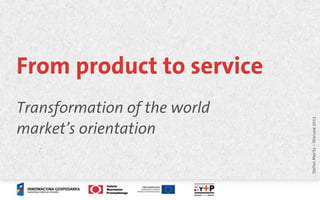Products to services ŌĆō transformation of the world markets orientation ŌĆō institute of design warsaw
- 1. From product to service Transformation of the world Stefan Moritz ŌĆō Warsaw 2011 marketŌĆÖs orientation
- 2. Signi’¼ücant paradigm shift 2 Stefan Moritz ŌĆō Warsaw 2011 From the industrial society To the networked society
- 3. Outoptimised 1900 1910 1920 1930 1940 1950 1960 1970 1980 1990 2000 Supply Organisational Chain Economic Psychology Management Theory 3 Organisational Change Management Management Taylorism Business Process Total Reengineering Quality Quality Stefan Moritz ŌĆō Warsaw 2011 Management Management (Japan) (USA) Activity- Based Costing Source: Adaptive Path
- 4. Value for the organisation Commodity Product Service Value for customers Experience Stefan Moritz ŌĆō Warsaw 2011
- 5. Shift 01 Things Experiences 5 Stefan Moritz ŌĆō Warsaw 2011
- 6. Shift 02 Owning Using 6 Stefan Moritz ŌĆō Warsaw 2011
- 7. Shift 03 7 Inside out Outside in Stefan Moritz ŌĆō Warsaw 2011
- 8. Transformation of the economy Service Dominant Logic 8 Product Culture Remainder Stefan Moritz ŌĆō Warsaw 2011
- 9. 10 Careers that didnŌĆÖt exist 10 years ago 1. Bloggers 6. Senior move management 2. Community managers 7. Social media strategists 9 3. Green funeral directors 8. User experience analyst 4. Interior redesigners 9. Video journalists Stefan Moritz ŌĆō Warsaw 2011 5. Patient advocates 10. Virtual business service providers http://msn.careerbuilder.com
- 10. Transformation of the economy PolandŌĆÖs GDP 10 agriculture 32% industry services Stefan Moritz ŌĆō Warsaw 2011 64% Source: www.cia.gov 2010
- 11. IBM 10% products 11 90% products 90% services Stefan Moritz ŌĆō Warsaw 2011 10% services
- 12. Gap 01 Investment in research 12 Ōé¼ 3,121.00 Ōé¼ 67.00 Stefan Moritz ŌĆō Warsaw 2011 Producing companies Service companies Source: Birgit Mager
- 13. Gap 02 Design e’¼Ćort 13 41% 6% Stefan Moritz ŌĆō Warsaw 2011 of producing companies see of service companies see design as integral any role of design Source: Design Council UK 2005
- 14. Gap 03 Gap 04 Productivity Quality Products Products 14 Service Service Stefan Moritz ŌĆō Warsaw 2011 Source: Estimate based on desk research
- 15. Proof point: Flylo check-in 15 Stefan Moritz ŌĆō Warsaw 2011 http://www.youtube.com/watch?v=BOrhMcqx6vw
- 16. ŌĆ£80% of companies believe they deliver outstanding value and a 17 superior customer experience. Stefan Moritz ŌĆō Warsaw 2011 8% of their customers agree.ŌĆØ Source: Bain & Company
- 17. Gap 05 Failure 18 60% 35% Stefan Moritz ŌĆō Warsaw 2011 of new service of launched services are introductions fail removed from the market after a short period Source: Cooper & Edgett 1996 / Stevends & Burley 2003
- 18. EXAMPLE Service Design for cars Stefan Moritz ŌĆō Warsaw 2011
- 19. From owning to using Stefan Moritz ŌĆō Warsaw 2011
- 20. Stefan Moritz ŌĆō Warsaw 2011
- 21. Stefan Moritz ŌĆō Warsaw 2011
- 22. Stefan Moritz ŌĆō Warsaw 2011
- 23. Stefan Moritz ŌĆō Warsaw 2011
- 24. Stefan Moritz ŌĆō Warsaw 2011
- 25. From owning to using $100M Stefan Moritz ŌĆō Warsaw 2011
- 26. SERVICE DESIGN Stefan Moritz ŌĆō Warsaw 2011
- 27. SERVICE DESIGN Experience prototyping with human empathy beyond products. Stefan Moritz ŌĆō Warsaw 2011
- 28. Services are di’¼Ćerent You have to be there. It happens over time. 25 You donŌĆÖt own it but use it. Stefan Moritz ŌĆō Warsaw 2011
- 29. ŌĆ£The only people that see the bigger picture 26 of any company are Stefan Moritz ŌĆō Warsaw 2011 their customers.ŌĆØ
- 30. Anders Frostenson 2010 27 Stefan Moritz ŌĆō Warsaw 2011
- 31. Anders Frostenson 2010 27 Stefan Moritz ŌĆō Warsaw 2011
- 32. Stefan Moritz ŌĆō Warsaw 2011
- 33. www.servicededesigntools.org Stefan Moritz ŌĆō Warsaw 2011
- 34. The six SD collaboration zones SERVICE DESIGN 30 Stefan Moritz ŌĆō Warsaw 2011 Understanding Thinking Generating Filtering Sensualisation Realising Finding out and Giving strategic Developing Selecting the Enabling Making it happen learning direction concepts most relevant understanding
- 35. SERVICE DESIGN Experience prototyping with human empathy beyond products. Stefan Moritz ŌĆō Warsaw 2011
- 36. 32 85%? 5% 99%! Stefan Moritz ŌĆō Warsaw 2011 Follow the logic of the customers
- 37. Experience prototyping 33 Stefan Moritz ŌĆō Warsaw 2011
- 38. Experience prototyping 33 Stefan Moritz ŌĆō Warsaw 2011
- 39. 34 Stefan Moritz ŌĆō Warsaw 2011
- 40. Mutual value Improve or innovate service experiences 35 Satis’¼üed + Pro’¼ütable + Lower risk Stefan Moritz ŌĆō Warsaw 2011 Customers Enterprises of failure
- 41. Thank you! 36 Stefan Moritz ŌĆō Warsaw 2011 st_moritz stefan@plusMoritz.com














































